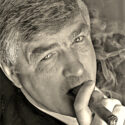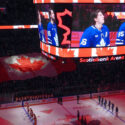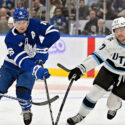TORONTO (Oct. 1) — Do not be surprised if the 2019–20 National Hockey League season is the most–prolific in the 103–year history of the Toronto Maple Leafs. If healthy, the Leafs could challenge for the Presidents’ Trophy as the No. 1 team in the regular season, a position the club hasn’t occupied since the six–team NHL of 1962–63. At the same time, don’t put your money on the Leafs ending their 52–year Stanley Cup drought. Unless the roster is specifically tweaked by general manager Kyle Dubas between now and next April, this Toronto club will fall short. Yet again. It is, in my view, exquisitely fashioned for the 82–game regular schedule. But, still, neither burly nor indomitable enough to withstand four grueling rounds of playoff toil.
You can argue until sundown about his generosity with players that have accomplished next to nothing in the NHL, but Dubas — after helping to lure John Tavares from the New York Islanders as a free agent — vowed to sign the club’s Big 3 draft picks out of entry–level… and succeeded. William Nylander (2014), Mitch Marner (2015) and Auston Matthews (2016) are locked up for at least five years, through the 2023–24 season. Morgan Rielly (signed through 2021–22) and newly–acquired Tyson Barrie (an unrestricted free agent next summer) provide the Maple Leafs their most–nimble defense tandem since Bryan McCabe and Tomas Kaberle a decade ago. Frederik Andersen, perennially a Vezina Trophy candidate and signed for two more years, remains the club’s No. 1 goalie. In regular–season play, Andersen ranks with any stopper of the post–1967 era, including Felix Potvin, Curtis Joseph and Ed Belfour. Where he lags behind the aforementioned is at playoff time; still without a series victory in Toronto and having imploded the past two springs, at Boston, in Game 7 of the opening round. Is Andersen a Stanley Cup–caliber goalie? To this point, there is scant evidence. If he proves to be less–than such a figure, it will offset everything the Maple Leafs have accomplished with their front–line personnel since bottoming out to 30th place in 2015–16.
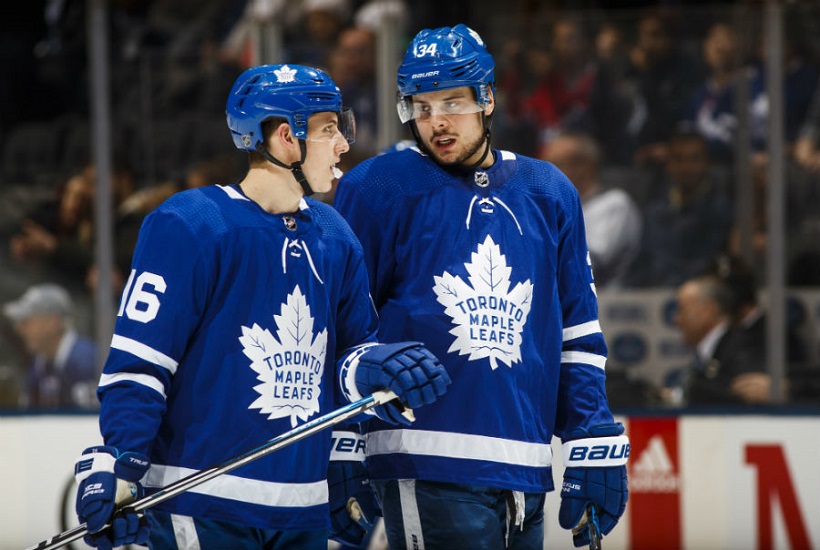
THE MAPLE LEAFS WILL AGAIN BE LOOKING FOR BIG SCORING SEASONS FROM ELITE FORWARDS MITCH MARNER (LEFT) AND AUSTON MATTHEWS. MARK BLINCH GETTY MAGES
When he traded the enigmatic Nazem Kadri to Colorado for Barrie on July 1, Dubas unloaded the final vestige of rancor and malice on the roster. Apparently, without reservation. The second–year GM is convinced the Stanley Cup can be won with skill and acumen while head–manning the puck. Size and hostility are marginal factors. To that end, Dubas has cobbled together a splendid version of his master plan.
The Maple Leafs are top–heavy and enormously talented — perhaps more–so than at any time since last winning the Stanley Cup. In order to end, however, the longest–such famine among current teams, the club will need to prevail much differently than even the defending champion. Anyone watching last spring’s final round, even casually, will have noted the malevolent underpinning of the St. Louis–Boston series. The teams pounded on one another, relentlessly, through seven laborious games; the Blues emerging with their first NHL title by virtue of a 4–1 victory at a quiet TD Garden on June 12. Even the most ironclad supporter of the Maple Leafs would have difficulty imagining last year’s club in such forbidding conflict through four rounds.
Has the Stanley Cup criterion changed in the course of 3½ months? If so, and providing Andersen can turn it up a notch or two when it matters, the Leafs are in a brilliant position to raise the trophy next June. If not, Dubas will need to supplement the roster before the NHL trade deadline; to sacrifice a bit of skill for scowl. And, counterbalance his abiding philosophy. Stubbornness by the young GM will result in more frustration for Toronto hockey fans. Flexibility, on the other hand, could be a determining factor. The Maple Leafs reside in a division with two other Cup contenders: Tampa Bay and Boston. And a third — Florida — that could make a power–move this season with the additions of Joel Quenneville behind the bench and Sergei Bobrovsky in goal. Montreal has a chance to improve. Buffalo, Ottawa and Detroit, the remaining Atlantic competition, is still well behind the pack. It’s these clubs that Toronto feasted on in the exhibition schedule — another reason for prescient hockey observers to ignore what happens on the ice in early–Autumn.

THE LEAFS WILL OPEN THE 2019–20 NHL SEASON TOMORROW NIGHT, AGAINST OTTAWA, AT SCOTIABANK ARENA.
Remember: the Leafs, under Mike Babcock, still haven’t won a playoff round. They need four–such triumphs in a two–month span to become NHL champion. Here are some predictions for the 2019–20 season:
LEAFS WILL FINISH: 2nd in the Atlantic (behind Tampa Bay) at 50–21–11 for a franchise–record 111 points.
TORONTO’S LEADING SCORER, again, will be Mitch Marner: 27 goals, 70 assists, 97 points.
THE LEAFS WILL finally win a playoff series (over Boston or Florida) but lose to Tampa Bay in Round 2.
HAVING LEARNED FROM THEIR shocking, first–round elimination last spring, the deep, gifted Lightning — without a noticeable weakness — will finally win the Stanley Cup, defeating… Calgary.
NHL PREVIEW MAGAZINES: 1967—1971
Among the most–treasured items in my large hockey collection are these NHL preview magazines from my youth — 1967 to 1971… as I transitioned from Grade to Junior–High school at eight to 12 years of age. On the eve of a new season, this is how the NHL looked in the early years of expansion, after the league doubled — for 1967–68 — from six to 12 teams. When Gordie Howe, Phil Esposito, Bobby Hull, Stan Mikita, Jean Beliveau and a young phenom, Bobby Orr, were the biggest names in the sport:
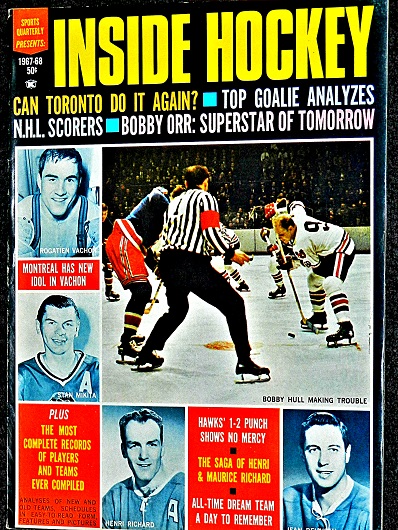
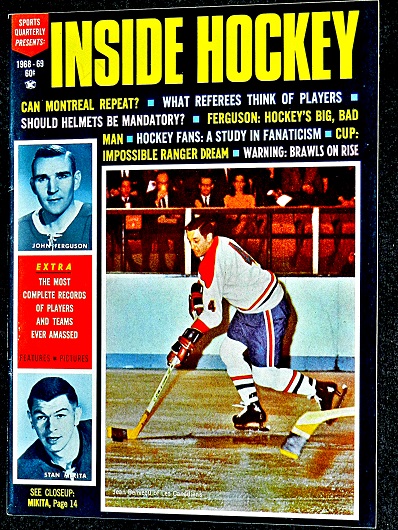
Sports Quarterly, a company on West 26th St. in New York, published INSIDE HOCKEY at the beginning of each season in the late–60’s and early–70’s. These are the first of six–such items in my collection: from 1967–68 (top–left) and 1968–69, the first two years of NHL expansion.
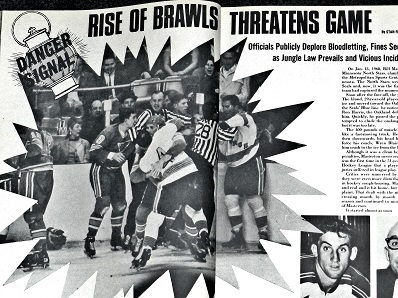
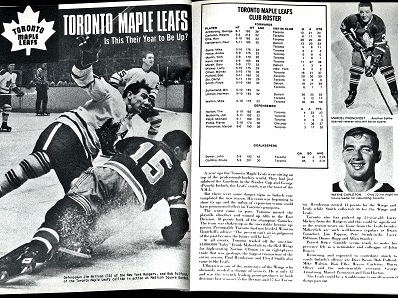
In 1967–68, the Maple Leafs were the defending Stanley Cup champion. But, a sub–.500 record against the six expansion teams (California Seals, Los Angeles Kings, Minnesota North Stars, Philadelphia Flyers, Pittsburgh Penguins, St. Louis Blues) knocked them out of the playoff picture as part of the established East Division (Boston, Chicago, Detroit, Montreal, New York, Toronto). To begin 1968–69, the embarrassing Leafs had some catching up to do, as detailed in the INSIDE HOCKEY article, below.
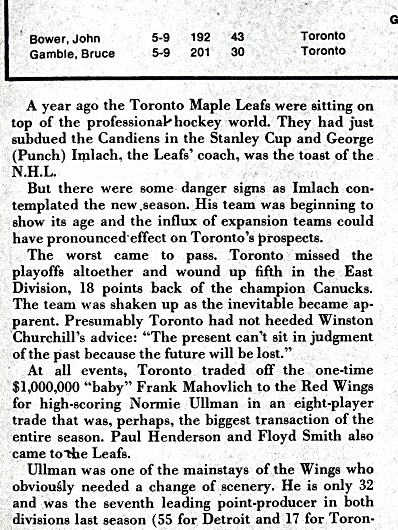
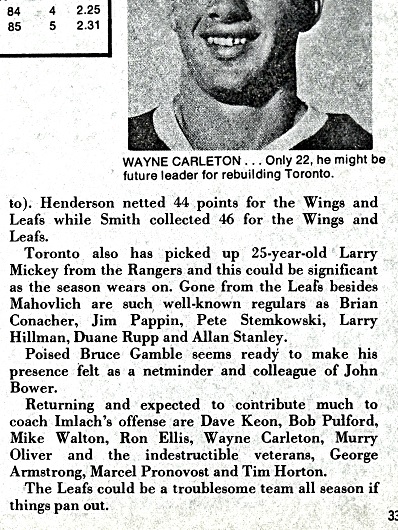
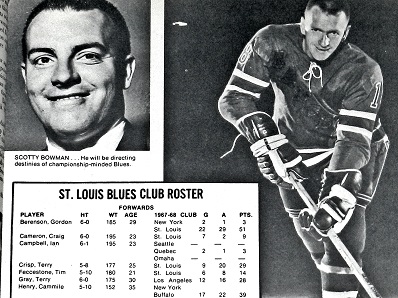
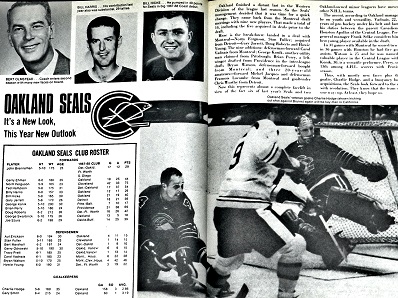
In the first season of expansion, the St. Louis Blues, coached by Scotty Bowman (top–left), recovered from a terrible start to represent the West Division in the Stanley Cup final, getting swept in four competitive games by Montreal. The Oakland Seals (top–right) were the worst of the new teams, winning just 15 of 74 matches.
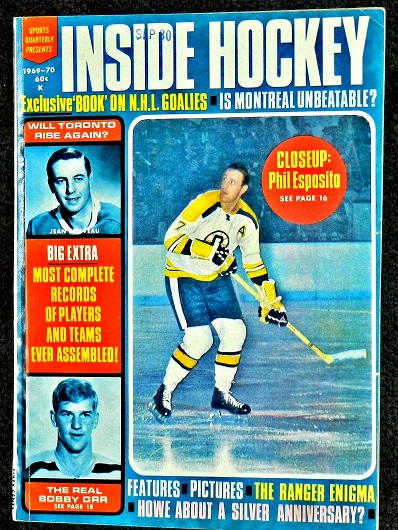
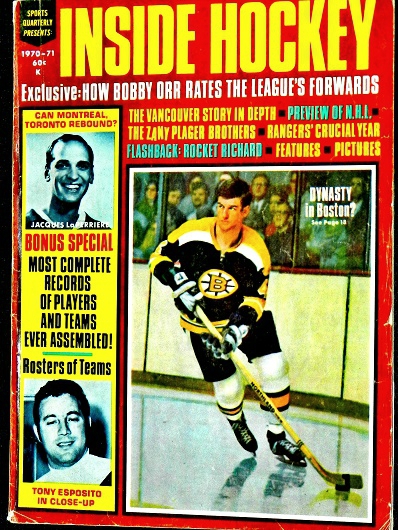
In 1969–70 (top–left), Phil Esposito, Bobby Orr and the Boston Bruins ended Montreal’s two–year Stanley Cup reign by defeating St. Louis for their first NHL title since 1941 — the four–game sweep of the Blues ending with Orr’s famous goal at 40 seconds of overtime at the Boston Garden. The unparalleled defenseman was on the cover (top–right) of INSIDE HOCKEY for the 1970–71 season.
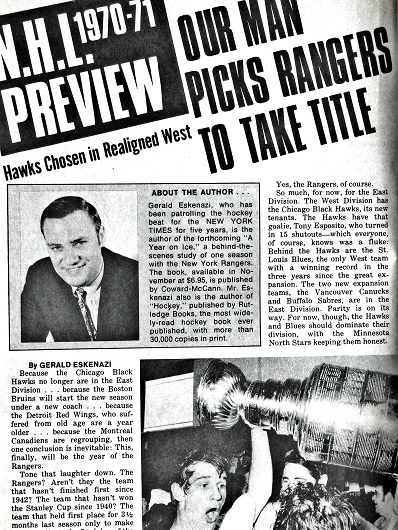
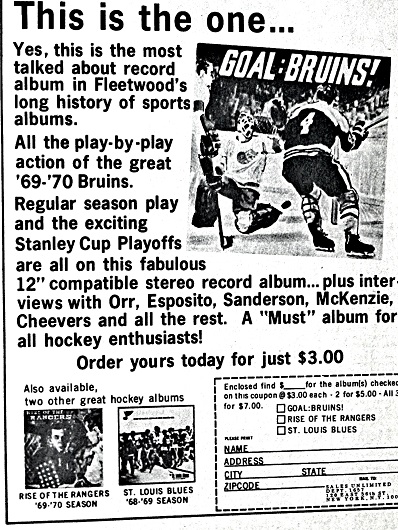
New York Times sports writer Gerald Eskenazi (now 83 years of age) penned six hockey books during his wonderful career and chose his home–town team, the Rangers, to win the 1971 Stanley Cup (top–left) while authoring the NHL preview for INSIDE HOCKEY. Ultimately, Montreal pulled off one of the biggest upsets in playoff history by downing Boston in the quarterfinals, then knocked off Minnesota and Chicago to reclaim the Cup. A vinyl record–album with calls from the Bruins’ Stanley Cup season in ’69–70 came out (top–right) in the summer of 1970. I cobbled together $3.00 and still have the rare souvenir (below).
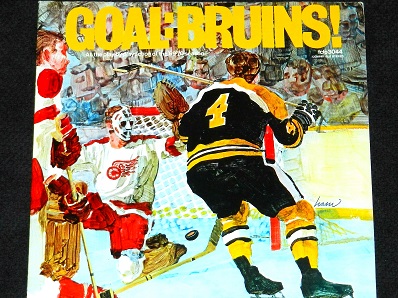
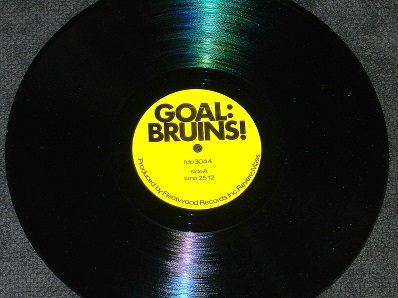
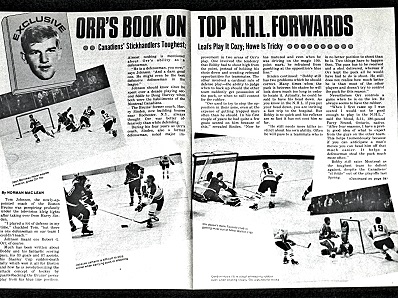
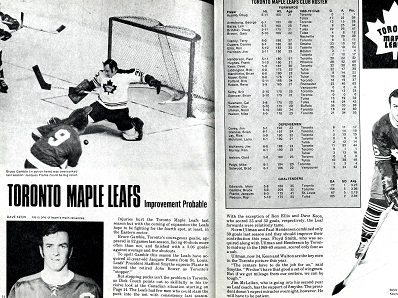
The 1970 Stanley Cup hero (and winner of the Conn Smythe Trophy) wrote about facing the best NHL forwards (top–left). Meantime, the silly Maple Leafs had a dreadful 1969–70 campaign, finishing last in the East Division and missing the playoffs by 21 points. The second–year tandem of GM Jim Gregory and coach John (not “Jim”) McLellan had lots to prove heading into 1970–71 (below).
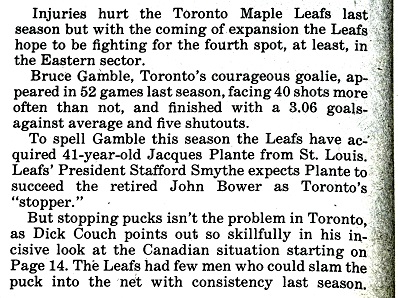
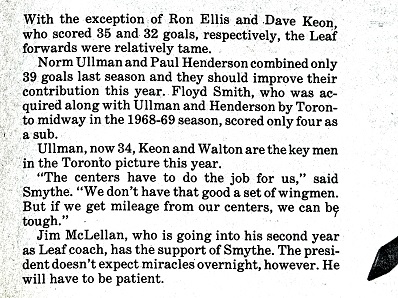
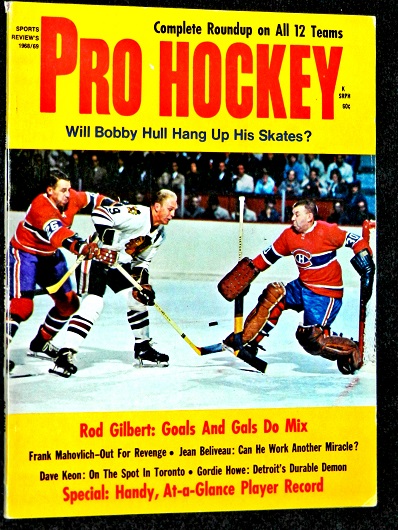
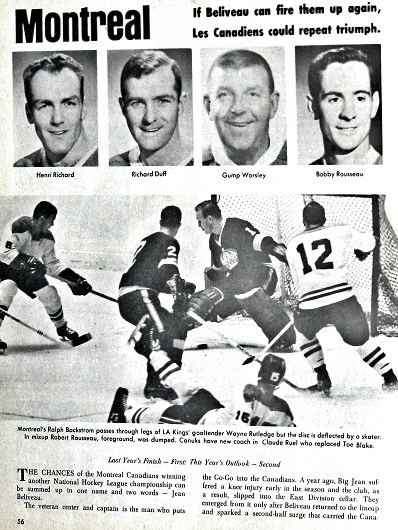
Back to 1968–69 (above) for a preview magazine offered by Splendid Publications Inc. at 880 Third Ave. in New York. The front–cover showed Bobby Hull of Chicago in front of Montreal goalie Gump Worsley while being checked by the Canadiens’ Jim Roberts (26). The Habs were the defending Stanley Cup champion. A photo (top–right) from the first year of expansion showed Montreal playing at Los Angeles. Yvan Cournoyer (12) and Ralph Backstrom (far–left) combined to score on Kings goalie Wayne Rutledge, with L.A. captain Bob Wall (2) looking on. The Leafs were hoping to bounce back from missing the playoffs, GM/coach Punch Imlach made what turned out to be a horrible swap, sending forward Jim Pappin to Chicago for aging defenseman Pierre Pilote. The photo of Pilote (below) in this magazine may be the worst mug–shot in NHL annals. It looks as if someone dragged poor Pierre out of the shower and stuck his finger in a light–socket.
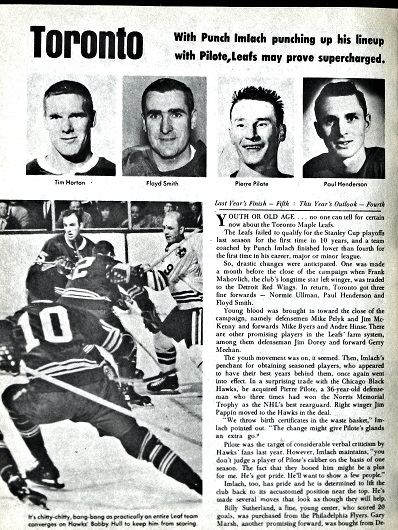

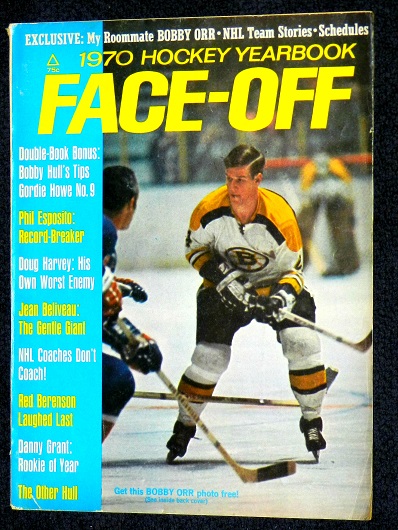
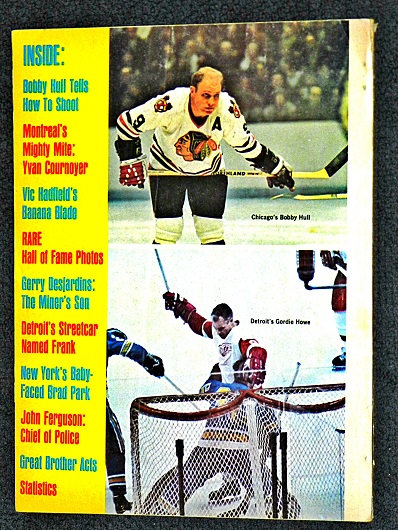
Who else but Bobby Orr should have graced the front–cover (top–left) of a preview magazine for 1969–70 — the season he would own… and ultimately end with his overtime goal against St. Louis? The FACE–OFF 1970 HOCKEY YEARBOOK was published by Popular Library Inc. at 355 Lexington Ave. in New York. Bobby Hull and Gordie Howe (scoring against the Blues’ Jacques Plante at St. Louis Arena) were on the colorful back–cover (top–right). Inside, were stories (below) on Orr and the ageless Mr. Hockey.
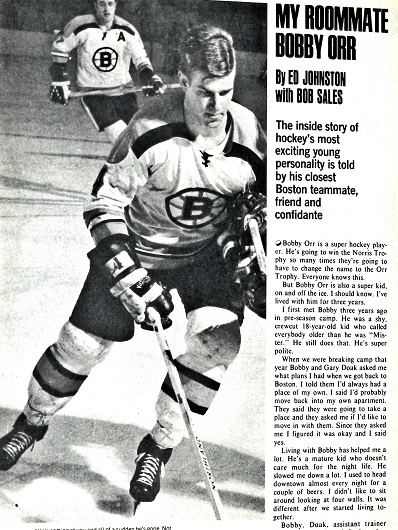
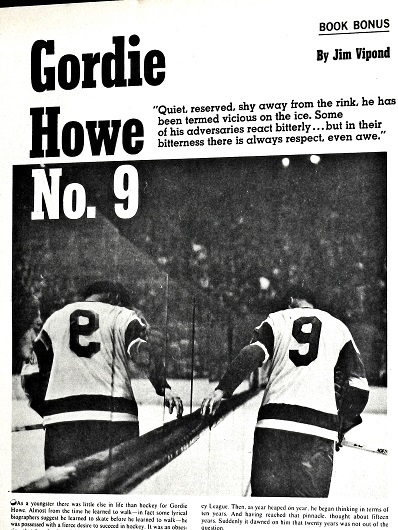
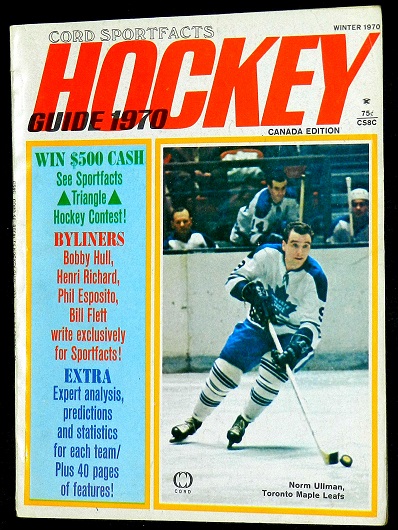
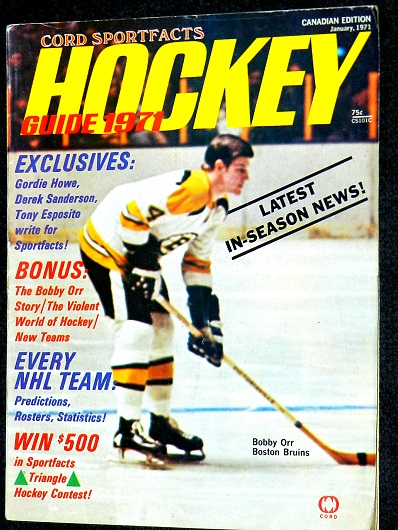
The CORD SPORTFACTS HOCKEY GUIDE for 1969–70 (top–left) and 1970–71 were published by Cord Communications Corporation at 145 East 52nd St. in New York. Norm Ullman of the Maple Leafs (skating at Madison Square Garden) was on the cover of the Canadian edition, with Bobby Orr on the latter issue.
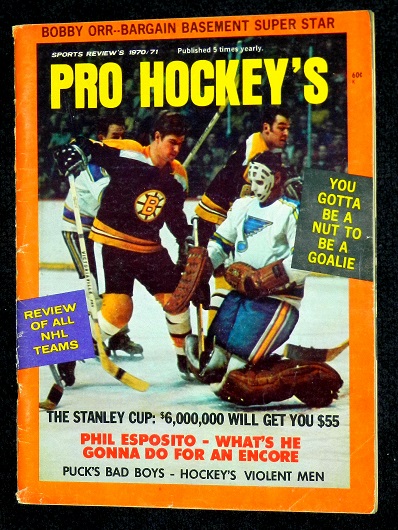
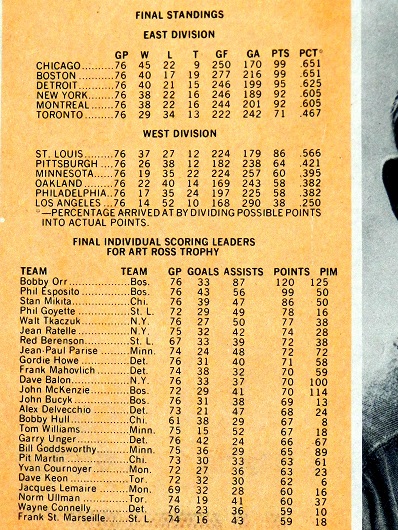
The SPORTS PREVIEW’S 1970–71 magazine was a product of Splendid Publications Inc. at 271 Madison Ave. in New York. All these years later, I still cannot fathom why there’s an apostrophe in the magazine title. Again, Bobby Orr graced the cover, in action against St. Louis during the 1970 Stanley Cup final. Standings and statistics from 1969–70 (top–right) were featured inside the publication.
EMAIL: HOWARDLBERGER@GMAIL.COM






























